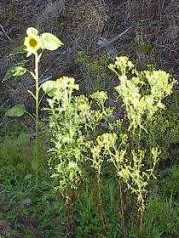Click on the plant name below for more information.

Bull Thistle
Canada Thistle
Common Evening Primrose
Japanese Knotweed
Policeman's Helmet
Scotch Broom
Tansy Ragwort
History
Bull Thistle is a native of Europe, western Asia, and northern Africa and
now can be found across the United States.
Description
This biennial plant grows between two to five feet in height. It has many
branches covered with green and brown spines and hairs. It has pinnate
shaped leaves that are hairy and prickly on the top and have a cotton feel on
the bottom. It blooms from mid-summer to early fall and has flowers
clustered at the end of the branches. The flowers are dark purple and are
approximately an inch and a half to two inches wide.
Organic Control
There are three biological control agents: the crown gall fly (Cheilosia
corydon), thistle seed head weevil (Rhinocyllus conicus), and seed-feeding fly
(Urophora stylata).
History
Canada Thistle is a native of southeastern Eurasia. Some sources claim it
was introduced by accident in the 1600's, others that it came via contaminated
seed from Canada.
Description
A perennial that blooms in midsummer, leaves wavy margined to
lobed, up to 6" long, armed with yellowish spines. Flowers in clusters that
spread with the wind. It has a deep root system that spreads horizontally, and
will form new plants. Given time one plant will form a large colony. As will the
roots if the ground is disturbed through cultivation etc. The seeds have a low
percentage of viability.
Organic Control
There are four approved bio-control agents in Oregon: a stem weevil, a seed weevil,
a crown weevil, and a stem gall fly.
Chemical Treatment
Areas can be treated by spot spraying individual plants over a period of weeks
with a broadleaf product. Since the leaves must have contact with the chemical
for it to be effective it is best to treat young plants to avoid overspray, and
excessive chemical use. Carefully follow label directions to avoid damage to
desirable vegetation growing around thistle. It will take a number of years to
remove all plants.
History
This is a native plant that can become weedy and invasive in some areas.
Description
This biennial, herbaceous plant can reach from one to eight feet in height.
It has a hairy, erect stem with lance shaped leaves that have a lightly serrated
edge. It blooms from early summer through mid-fall with bright yellow to
gold flowers with four petals. The flowers are partially to completely
closed during the day and open up at night.
Photograph 1,
Photograph 2
History
This plant originated from Japan and was introduced as an ornamental plant
in North America in the near the end of the 19th century.
Description
Japanese Knotweed is a perennial that reaches up to nine feet in height.
It has reddish-brown stems with broad, oval-shapped leaves. This plant
blooms from mid-summer to mid-fall with white or cream flowers clustered in a
plume like structure at stem ends. It can be very invasive in soil that
has been recently stripped of vegetation after flooding.
Chemical Treatment
Mowing is not an effective control for this persistent plant. However, it
can be treated with approved herbicides.
History
This native of India and western Himalaya was introduced to the United Kingdom
in the 1900's and later in North America.
Description
Policemanís helmet is an herbaceous annual that can grow up to 10 feet in
height. It has easily broken, smooth, and hairless stems with oblong,
serrated edge leaves usually group in three leaves per node. The plant
received its name from the English policeman's helmet shaped flowers.
These are solitary, five petal flowers ranging in color from white to various
shades of pink.
Photograph, Photograph of Seed Beetles
History
Scotch Broom is a non-native, invasive plant. It is a European native
and was introduced to the United States in the 1800's.
Description
Scotch Broom is a perennial, evergreen shrub that may grow up to 10 feet in
height. This plant is characterized with many angled, dark green branches
and small leaves. It blooms from spring to early summer with an abundance
of small yellow flowers. Mature plants produce a large amount of long
lived seeds each year.
Organic Control
Currently, there are three biological control agents: seed beetle (Bruchidius
villosus), seed weevil (Exapion fuscirostre), and the twig miner moth (Leucoptera
spartifoliella). These three agents have been released in Oregon.
History
In 1922, the first documented site of tansy ragwort was recorded in
Multnomah County.
Description
Tansy Ragwort is a biennial grows between one and a half feet to six feet tall.
This plant has multiple branched stems with dark green, deeply lobed leaves.
It blooms from midsummer to fall with numerous small yellow flowers. The seeds
can remain dormant in the soil for 15 years. This plant is more commonly
found in western Oregon than eastern Oregon.
Toxic
Tansy ragwort is toxic when ingested causing irreversible liver damage.
It is a danger to cattle, horses, and other grazing animals.
Organic Control
Currently, there are three biological control agents: a seed head fly, a flea
beetle, and a moth. These three agents have been released in Oregon.
Last updated: Thursday, January 30, 2020 04:46 PM